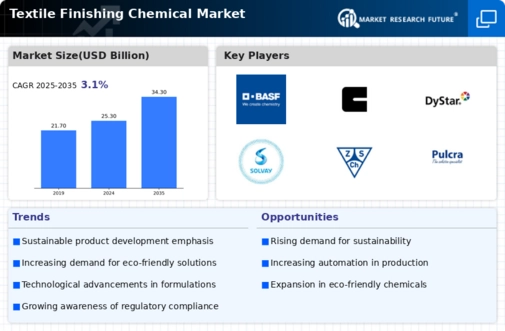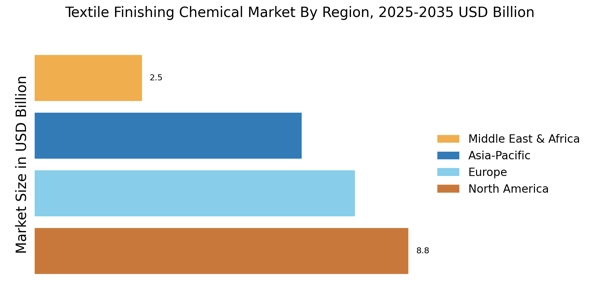The Textile Finishing Chemical Market is currently characterized by a dynamic competitive landscape, driven by innovation, sustainability, and strategic partnerships. Key players such as BASF SE (Germany), Dow Inc. (US), and Huntsman Corporation (US) are actively shaping the market through their operational focuses. BASF SE (Germany) emphasizes sustainable solutions, aiming to reduce environmental impact while enhancing product performance. Dow Inc. (US) is leveraging digital transformation to optimize its supply chain and improve customer engagement. Huntsman Corporation (US) is pursuing strategic acquisitions to expand its product portfolio and market reach, thereby enhancing its competitive positioning. Collectively, these strategies indicate a shift towards a more integrated and sustainable approach within the industry, fostering a competitive environment that prioritizes innovation and environmental responsibility.
In terms of business tactics, companies are increasingly localizing manufacturing to reduce lead times and enhance responsiveness to market demands. Supply chain optimization remains a critical focus, particularly in light of global economic fluctuations. The market structure appears moderately fragmented, with several key players exerting significant influence while also allowing for niche players to thrive. This fragmentation suggests a competitive environment where collaboration and strategic alliances may become essential for maintaining market share and driving growth.
In August 2025, Clariant AG (Switzerland) announced a partnership with a leading textile manufacturer to develop eco-friendly finishing agents. This collaboration is strategically significant as it aligns with the growing demand for sustainable textile solutions, positioning Clariant AG (Switzerland) as a frontrunner in the eco-conscious segment of the market. The partnership not only enhances Clariant's product offerings but also reinforces its commitment to sustainability, which is increasingly becoming a key differentiator in the industry.
In September 2025, Solvay SA (Belgium) launched a new line of textile finishing chemicals designed to improve durability and performance while minimizing environmental impact. This product launch is indicative of Solvay's focus on innovation and sustainability, reflecting a broader trend within the market towards developing high-performance, eco-friendly solutions. By prioritizing these attributes, Solvay SA (Belgium) aims to capture a larger share of the market, appealing to environmentally conscious consumers and manufacturers alike.
In October 2025, Archroma (Switzerland) unveiled a digital platform aimed at enhancing customer engagement and streamlining the ordering process for its textile finishing chemicals. This initiative highlights Archroma's commitment to digital transformation, which is becoming increasingly vital in the competitive landscape. By integrating technology into its operations, Archroma (Switzerland) not only improves efficiency but also enhances customer satisfaction, potentially leading to increased loyalty and market share.
As of October 2025, the competitive trends within the Textile Finishing Chemical Market are heavily influenced by digitalization, sustainability, and the integration of advanced technologies such as AI. Strategic alliances are playing a crucial role in shaping the current landscape, enabling companies to pool resources and expertise to drive innovation. Looking ahead, it appears that competitive differentiation will increasingly hinge on factors beyond price, with a pronounced emphasis on technological advancements, sustainable practices, and reliable supply chains. This evolution suggests that companies must adapt to remain competitive, focusing on innovation and customer-centric solutions to thrive in a rapidly changing market.


















Leave a Comment